Reel tech has come so far that virtually any brand is a good one, but which reel truly suits your needs? Discover how to select a great inshore baitcaster.
How to pick a great inshore baitcaster
I have had experience with more than a few brands. Let me take it from the top so you make a good decision and have fun fishing!
Why use a baitcaster in the first place? Baitcasting reels give you more control and power over your lure.
I already wrote about this in You Need to Start Using a Baitcaster. I make some pretty solid arguments in that article!
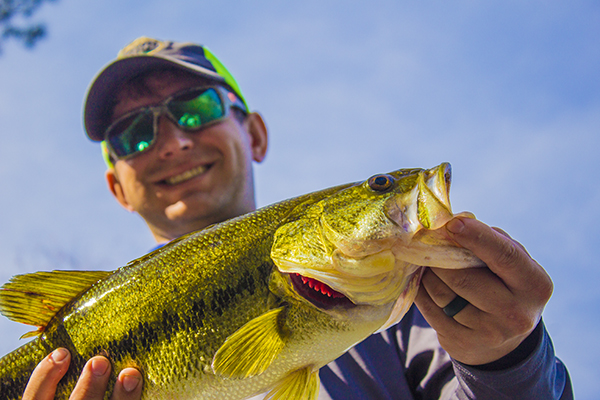
This pretty largemouth bass was pulled off of her bed in Lake Okhissa. It was only possible with the precision of a good baitcaster.
What to Look for in a Baitcasting Reel
Reel Drag
Used to, your thumb was your "drag." If you wanted to turn a fish's head during a fight you put your thumb down on the spool and pulled hard, not letting any line out.
Things are different now. Today's baitcasters incorporate a drag function designed to pay out fishing line based upon how hard the fish is pulling.
Make the drag too strong and no line will pay out, possibly breaking the line. Make it too weak and hooksets won't be effective, or a big fish could spool the reel.
Different Drags for Different Fish
Speckled trout and redfish swim in the same water, but require different drag settings.
Speckled Trout
Speckled trout are called "weak fish" because they don't fight as hard as other species.
In fact, I use a lighter drag setting for speckled trout because their mouths are soft. I don't want to rip the hook out of their mouth!
Redfish
When I am sight fishing for redfish I want to use a strong drag, because redfish are much heavier and stronger than trout. I can't let them wrap themselves around cover or peel all my line off the spool.
Used to, I kept the majority of the redfish I caught, but today I no longer do.
Instead, I tag redfish for TAG Louisiana. Because I am tagging and releasing the redfish, I need them to be in good condition with plenty of fight left so they survive the event.
Yes, it is possible to kill a redfish from fighting it alone, I have experienced this first hand. With a strong drag I am capable of reeling the fish straight to the boat before they have time to wear themselves out.
I have two reels I enjoy for this kind of fishing:
- 13 Fishing's Concept A
- Abu Garcia's Revo Inshore
Both are great reels with strong drags.
The Concept A is built with a Bulldog Drag System sporting 22lbs of drag and the Revo Inshore uses Abu Garcia's Carbon Matrix drag system providing 20lbs of drag.
I have caught and released redfish on both of these reels and I am very happy with them.
Quick Note on Speckled Trout and Heavy Drag
You want a heavy drag so you can be prepared.
It is not uncommon for bull redfish to smash a school of feeding trout, disrupting your trout-catching experience.
If and when they bite your line, you want to land them, wearing them out enough they leave your trout alone and go somewhere else.
A prolonged fight can cause you to nearly lose your tackle or have the trout swim away to somewhere else. Not all of my reels have 20lb+ drags, but when I am tossing one I know I can beat that redfish up in a hurry and save the trout bite.
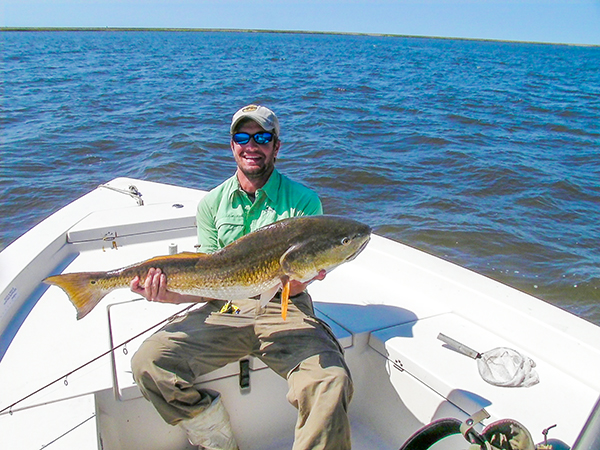
Big bull reds like this will hose a trout bite. Catch them and get them in the boat fast to keep your trout from being chased away.
If I don't have a heavy enough drag, I just go old-school and use my thumb!
Reel Braking Systems
This is often overlooked by anglers when selecting a baitcasting reel. Let me gloss over what has performed best for me.
Brakes on a baitcaster are designed to help anglers avoid dreaded backlash. Backlash is the result of the spool spinning faster than line can leave it.
Braking systems are designed to even out the RPM of the spool and slow it down in parts of the cast it may be spinning too fast.
There are three types of braking systems:
- magnetic
- centrifugal
- combination of the two
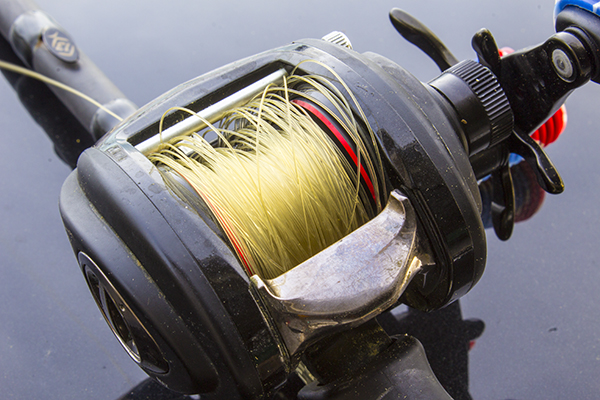
Control backlash with a braking system and, of course, good ol' fashioned skill.
Magnetic Braking Systems
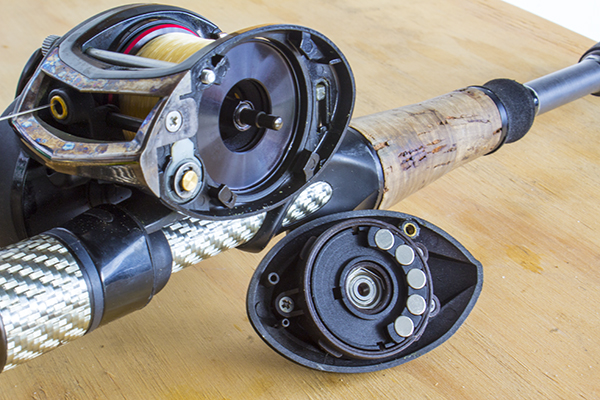
Magnetic braking systems are good, but not the best within inshore fishing. Note the row of magnets that face the spool when installed.
The magnetic braking system consists of a series of magnets that constantly act upon the spool, smoothing out its RPM as it turns and slowing it down as the cast is nearly finished.
Personally, I don't like magnets, they just don't seem to work well, but other anglers I respect prefer them.
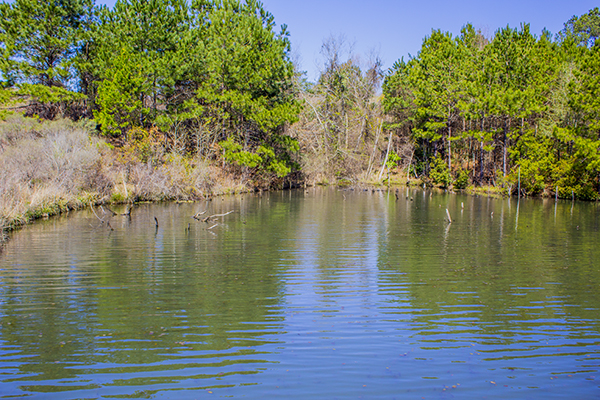
This cove in an inland lake is protected by trees from strong wind. We do not have this luxury in the marsh and often battle wind when using baitcasters.
Centrifugal Braking Systems
Centrifugal braking systems are comprised of a series of weights that, when rotating, lock outwards against a brake drum and create friction, slowing the spool down.
My favorite thing about centrifugal brake systems is their "tunability". Abu Garcia's Revo Inshore uses two kinds of centrifugal brakes, one set spring loaded and the other not.
They are designed this way to create even braking on the beginning of the cast (when the spool is launched from a dead stop to its max RPM) and the last part of the cast (when the lure is about to hit the water and the spool needs to slow down significantly).
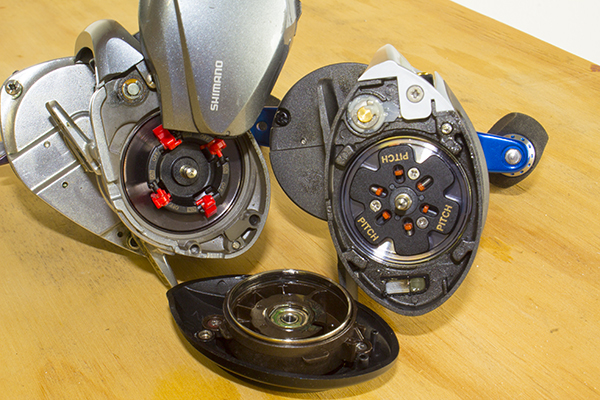
Pictured are centrifugal brake systems from two different manufacturers, Shimano on the left and Abu Garcia on the right.
Baitcaster Reel Gear Ratio
This is a ratio dictating the number of reel handle rotations to spool rotations. For example, a spool with an 8:1 gear ratio will turn 8 times each time the handle is turned once.
A high gear ratio of 8:1 is usually better suited for topwater lures, where you need to quickly retrieve up slack (since the lure will drift towards you with each twitch). A 5:1 gear ratio is great for slow retrieves, like with a spinnerbait or deep-diving crankbait.
An "all purpose" gear ratio would be something like 6.5:1.
Why is selecting a gear ratio important? Can't one just reel faster or slower regardless of gear ratio?
Yes, you can, but compensating for a poorly selected gear ratio by reeling faster is the equivalent of running a marathon in a pair of hiking boots: you can, it is possible, but it is not efficient.

Pictured are centrifugal brake systems from two different manufacturers, Shimano on the left and Abu Garcia on the right.
Used to, the trade-off with higher gear ratios is that they tend to bind under stress. Today's reel tech is so advanced anglers don't worry about this trade-off.
In fact, a lot of bass anglers are going to 7:1+ gear ratios across the board. The idea is you can always reel slower but you can't reel faster without disrupting your presentation.
Speaking of bass anglers...
Chad Battles made a very good point on LAFR in a baitcaster discussion on LAFR.
Gear Ratios are deceptive and fail to reflect the actual speed of retrieve. The key to finding retrieve speed is Inches Per Turn.
Gear ratio is not nearly as relevant as IPT. Inches Per Turn measures how many inches of line a reel brings in with a complete turn of the handle.
An example of a fast reel is 29" per turn and a slow reel would be 22" per turn.
Lagniappe for Selecting a Baitcaster
These things won't make or break your choice when you select a great inshore baitcaster, but they are good to know.
Gear Material
You want metal gears for the spool and handle. Everything else can be plastic, that is fine, but those parts must be metal, preferably brass. Virtually every reel out there uses metal gears, so this has become fairly standard but still worthy to notate.
Size of Spool
Size of the spool is relevant because it dictates how much line you are going to put on it.
To be honest, I don't see a need for having 200 yards of line, inside the marsh or out of it. We are targeting specks and reds, not yellow fin tuna.
Spool size is not a deal-breaker, it is just something you should be aware of.
Ergonomics
Ergonomics, in the world of inshore fishing, directly impacts fishing stamina.
Louisiana has the world's best inshore fishing, but that doesn't mean all days are short and easy.
No, some fishing trips require a long grind, standing all day on the bow, holding a rod and reel in your hand. When I refer to something being "ergonomical" I am referring to it being comfortable to hold and use. This is key when you select a great inshore baitcaster.
You don't want to spend all day holding a heavy reel, it can wear out your hands and make fishing less enjoyable. I have found that a good weight for a reel is around 7-8 ounces.
Some are lighter, some are heavier, it will ultimately be your call as to whether or not the reel's weight is good for you.
Length of throw is another element of baitcaster design. It is easier to apply force when turning a reel handle if the handle is longer.
This is basic mechanical engineering. A shorter handle gives less leverage, whereas a longer handle gives more.
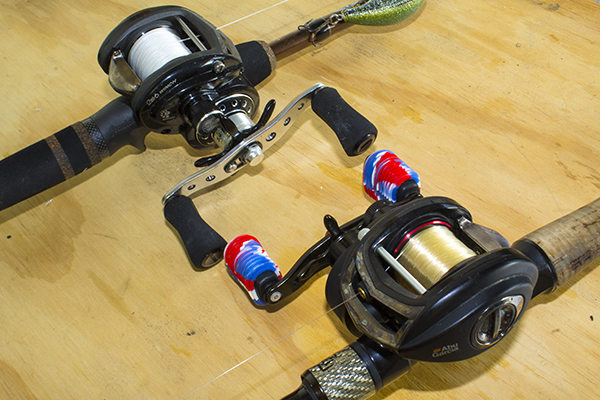
The Winch (pictured top left) has a longer length of throw than the Revo SX, giving you more cranking power when horsing in big fish.
When it comes to fishing reels and ergonomics the best way to decide is to hold the reel in your hand. Most tackle stores will let you do this.
Reel Cleaning
Some reels have lubrication ports that makes lubing them very easy. Other reels do not and require being taken apart in order to be lubricated. I am comfortable with doing this, but if you are not then it is suggested you go to a reel technician to have this work done.
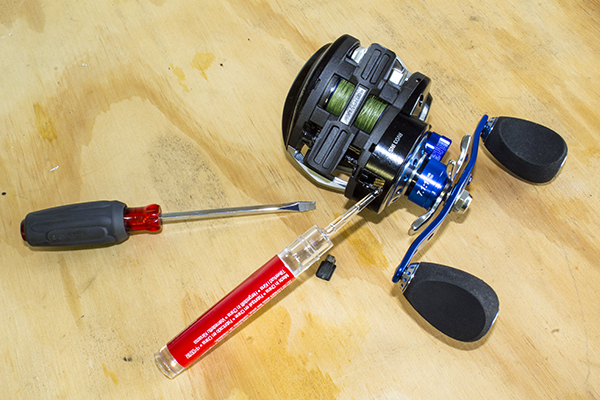
The lube port on this reel makes it easy to keep oiled and operating smoothly.
Number of Bearings
Warning! The number of bearings is just a marketing gimmick.
It's a number that has squat to do with the performance of a baitcasting reel. Just walk away if a salesperson rambles on about the number of bearings. They don't know jack about fishing and can't help you.What's actually important is bearing quality.
There are so many specs that go into bearing quality, such as the type of material used, the grade of that material, ball precision and size of bearing tolerance (measured in ABEC scale).
Reel manufacturers rarely, if ever, disclose this kind of information, but there are plenty of aftermarket reel bearing companies who do.
The most important bearings are those on either side of the spool and the main gear.
In a nutshell, I'd much rather have a reel with seven high quality bearings than ten with crappy bearings.
Conclusion
At the time of this writing, my favorite baitcaster is a 13 Fishing Concept A or Concept C.
The Concept A isn't as expensive and, honestly, the only difference between the two is that the Concept C is a little lighter and has bearings supporting the worm gear instead of bushings.
The Concept reels are light, easily palmed and I have used both to tag 1,000+ speckled trout this tagging season, as well as sight fish redfish. I use both in 7.3:1 or 8.1:1 gear ratio.
Knowing how to select a good inshore baitcaster will aid you on your fishing adventures. It's a surefire way to ensure you get those fish in the boat.
Tight lines, y'all!
P.S.Did you find what you learned here to be useful? Consider joining my newsletter to be notified when more like it publishes.
P.S.
Did you find what you learned here to be useful? Consider joining my newsletter to be notified when more like it publishes.

I’d go with the Daiwa. It’ll probably last longer.
So I’m trying to decide upon a new baitcasting reel for inshore fishing going after flounder, redfish, speckled trout, with a black drum occasionally, and I’m stuck between the Daiwa Coastal SV TW 150, and the Lew’s Custom Inshore Baitcast Reel. Both seem very good and have good reviews, but I’m unsure which one would be the better option.
Thanks, Gene! The compliment means that much more coming from an SME.
Excellent article. I have a reel repair business n the Miss Gulf Coast. I appreciate it when someone is accurate in their articles.
Once every few months.
How often do you break down and clean your reels? Also how often do you apply corrosionX on them?
That’s a nice reel! Shimano has a great fit and finish. Thanks for commenting!
After some serious thought I finally bought my first baitcasting reel ever. Never used one before. Did some research and went with the Shimano Curado K. After watching some YouTube videos on how to use them and fine tune to avoid backlashes. I love using it over a spinning reel.
You know, I really don’t, at least not an article geared towards that exact thing.
I just put that in my list of stuff to do.
Thanks for commenting!
I was wondering if you had an article on rod/reel maintenance? If not, is this something you could possibly cover in the future?